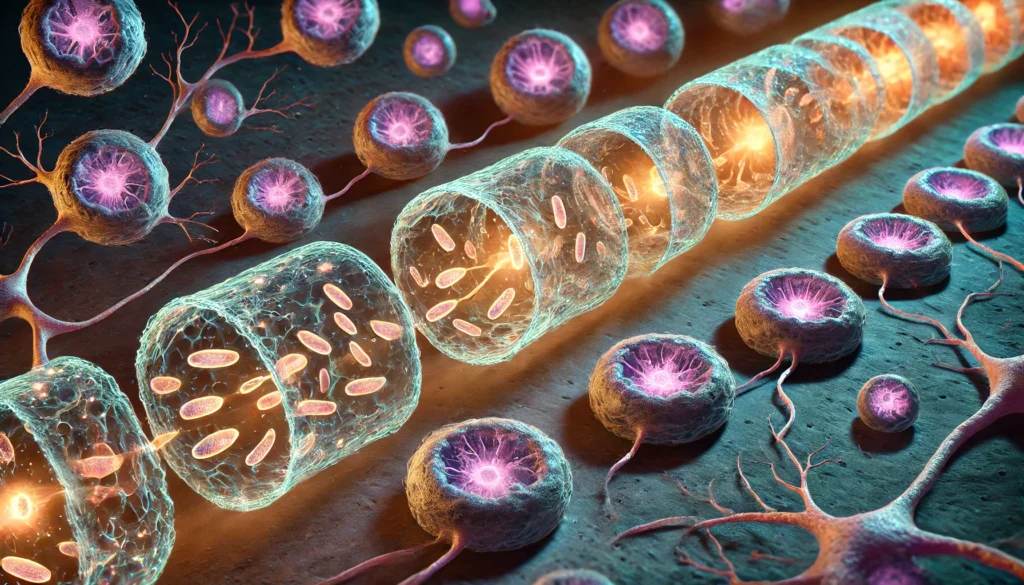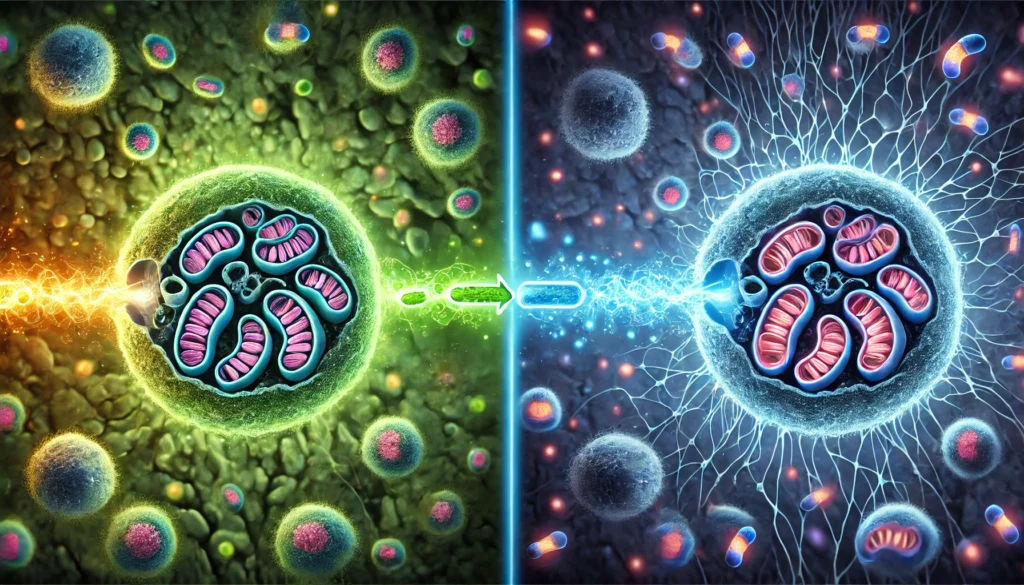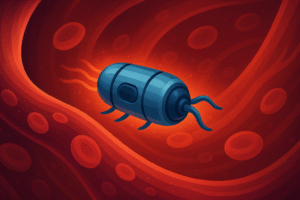Fun Fact: Did you know your cells can borrow powerhouses from each other—literally?
For over a century, biology textbooks taught us that mitochondria—the so-called “powerhouses of the cell”—live quietly inside individual cells, converting food into energy and minding their own business. But recent discoveries suggest that mitochondria might actually be on the move—travelling between cells to help, heal, or in some cases, harm.
Yes, you read that right. Your cells might be swapping mitochondria like emergency energy kits—and this odd biological behavior could unlock new ways to treat diseases like cancer, stroke, and heart failure.
Let’s take a look at this strange but exciting science and what it could mean for your health.
What Are Mitochondria, Really?
Mitochondria are small structures inside almost every cell in your body. Their main job is turning the nutrients you eat into adenosine triphosphate (ATP), the molecule that powers everything your cells do.
But that’s not all. Mitochondria:
- Help your cells communicate with one another
- Influence how cells grow, divide, or die
- Play a key role in immune responses
They even have their own tiny DNA—evidence that they evolved from bacteria billions of years ago. So technically, each of your cells has a bunch of ancient bacterial roommates.
Mitochondria on the Move
Until recently, scientists believed mitochondria stayed put inside cells. That’s changing fast.
A new wave of research shows that cells sometimes send their mitochondria to other cells, especially when there’s trouble. This process, called mitochondrial transfer, has been observed in:
- Mice
- Human cell cultures
- Organisms like yeast and molluscs
But why would cells give away their energy engines?

Real-Life Rescue Missions
Stroke Recovery in Mice
In one study at Massachusetts General Hospital (a research hospital in Boston, USA), scientists saw astrocytes (support cells in the brain) deliver mitochondria to injured neurons after a stroke. The neurons started growing again and showed signs of recovery.
Healing Lungs in Inflammation
At Columbia University (a research university in New York City), Dr. Jahar Bhattacharya and his team found that stromal cells (cells that support tissues) transferred mitochondria to lung cells in mice suffering from severe inflammation. The result was faster healing and higher energy levels.
Faster Wound Healing
At Sorbonne University in Paris, researchers discovered that platelets (blood cells that help with clotting) could give their mitochondria to stem cells. These energized stem cells then released molecules that sped up the creation of new blood vessels, helping wounds heal faster.
How Do They Do It?
Mitochondria move from one cell to another in a few different ways:
- Tunneling nanotubes: Tiny, tube-like bridges between cells
- Vesicles: Bubble-like packages that travel through body fluids
- Freely in blood: Some mitochondria float independently in our bloodstream
This means cells don’t just stay in their lanes—they collaborate to keep tissues healthy.
Everyday Use or Emergency Backup?
Mitochondrial transfer often appears during cell stress or damage. But researchers think it might also happen during normal, everyday tissue maintenance.
Examples include:
- In mice, fat cells give mitochondria to macrophages (immune cells), helping them function better.
- In the brain, astrocytes donate mitochondria to blood vessel lining cells, helping maintain the blood-brain barrier, which keeps harmful substances out of the brain.
The Dark Side: When Cancer Gets Involved
Not all mitochondrial sharing is beneficial.
Some studies suggest that cancer cells steal mitochondria from healthy cells. This may:
- Help them resist immune system attacks
- Make them more invasive
- Speed up tumor growth
In one human study, scientists found mutated mitochondria from cancer cells inside immune cells, possibly weakening the body’s natural defenses.
The Technology Challenge
Seeing this process in real humans is difficult. Why?
- Fluorescent tags, which help scientists track mitochondria in lab settings, are too risky for human use.
- The best current method is comparing mitochondrial DNA (mtDNA) in different cells, but that doesn’t always prove that the entire organelle moved.
Despite these challenges, many experts believe mitochondrial transfer is happening in the human body more often than we know.

Future Treatments: Can We Use This for Good?
Scientists are now testing whether they can harness mitochondrial transfer to treat disease. Here are some approaches in development:
Mitochondrial Transplants
Researchers are trying to directly insert healthy mitochondria into diseased cells, especially for conditions like:
- Leigh syndrome (a rare genetic disorder)
- Heart disease
- Stroke
Mitochondrial Augmentation Therapy
This method involves adding mitochondria to a person’s stem cells in the lab and then returning those boosted cells to the body.
Boosting Immune Cells Against Cancer
At the Leibniz Institute for Immunotherapy in Germany, Dr. Jeremy Baldwin showed that T cells receiving mitochondria from stromal cells became more powerful tumor fighters in mice.
Triggering Natural Mitochondrial Transfers
At Washington University, a team led by Jonathan Brestoff transplanted bone marrow into sick mice. The donor stem cells released mitochondria that spread through the body and improved neurological function and survival.
Big Questions That Remain
There is still much we do not know. For example:
- What triggers mitochondrial transfer?
- Why do some cells donate while others receive?
- Do mitochondria always help, or can they sometimes harm?
- How long do donated mitochondria last inside a new cell?
Further research is essential to answer these questions.
Why This Matters
If scientists can control or boost mitochondrial transfer, it could lead to new treatments for:
- Autoimmune disorders
- Cancer
- Brain injuries
- Heart attacks
- Chronic inflammation
- Genetic mitochondrial diseases
In short, these tiny transfers could lead to major medical breakthroughs.
Conclusion: A New Frontier in Medicine?
What began as a surprising lab observation has grown into a fascinating area of study. The idea that our cells might borrow or donate mitochondria to survive, heal, or even manipulate one another is changing how we think about health.
While more research is needed, especially in humans, the potential for using mitochondrial transfer in medicine is huge. These little powerhouses might hold the key to healing from the inside out.
Author’s Note:
This blog is based on recent research published in Nature and other scientific journals. The goal was to make complex biology accessible and relevant to everyone, because science is for all of us.
G.C., Ecosociosphere contributor.
References and Further Reading:
- Nature Article: https://www.nature.com/articles/d41586-025-01064-5
- How secret conversations inside cells are transforming biology: https://www.nature.com/articles/d41586-024-00437-4




